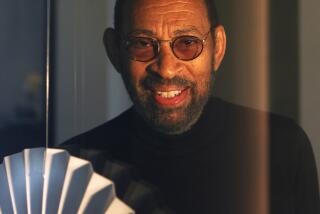A ‘Guys and Dolls’ Just Like Harlem
SAN DIEGO — If you’re going to do a show about gamblers leading the sportin’ life in Manhattan in the middle of the 20th century, Maurice Hines says, getting it right means going for racial diversity.
In 1950, the all-white original cast of “Guys and Dolls” sent audiences home humming “Luck Be a Lady,” “Sue Me,” “I’ve Never Been in Love Before” and other Frank Loesser gems. In 1976, Hines starred in a touring revival as Nathan Detroit, proprietor of “the oldest established permanent floating crap game in New York.” That “Guys and Dolls” had an all-black cast that also featured Debbie Allen, Leslie Uggams and Richard Roundtree.
For the record:
12:00 a.m. April 21, 2002 For the Record
Los Angeles Times Sunday April 21, 2002 Home Edition Los Angeles Times Magazine Page 2 Calendar Desk 1 inches; 21 words Type of Material: Correction
Misspelled author’s name--Author Damon Runyon’s last name was spelled incorrectly in an April 14 story about Maurice Hines and “Guys and Dolls.”
In the latest major production, launched at the Arena Stage in Washington, D.C., in 1999 and opening Wednesday at the Wilshire Theatre in Beverly Hills, Hines is Nathan once again. But the world in which he moves is populated this time by blacks and whites.
That, says Hines, reflects what he saw as a kid growing up in Harlem. Two of his mother’s brothers were gamblers, flashy dressers who fancied themselves Cab Calloway-style bon vivants. He remembers running around his grandmother’s house with his younger brother, Gregory, while the card and dice games were in session. By the time they were 10 and 8, respectively, Maurice and Gregory had made their Broadway debuts in a short-lived 1954 musical called “The Girl in Pink Tights.”
“My uncles had friends who were white, Asian, black, Hispanic. They all had one thing in common--they were gamblers,” Maurice Hines said. “All-white company of ‘Guys and Dolls’ in 1950? Wrong! All-black company in the 1970s? Wrong! If you celebrate New York, you celebrate all cultures. That’s why I think the world should see this show.”
Hines was holding forth in the lobby of a San Diego hotel, where he had settled in for a long round of interviews to drum up interest in the Southern California leg of the “Guys and Dolls” tour. Tall, slender, and clad on this day in black leather and black denim, Hines prides himself on playing Nathan larger than life.
When he was small, Hines was quiet and withdrawn--so much so that when someone from a local dance studio came knocking door to door one day with an offer of free lessons, his uncle urged his mother to send the boy.
“Uncle Li said, ‘He’ll meet kids; maybe he’ll talk more,’” Hines said. The dance floor brought out a spinning dervish. Maurice taught Gregory what he learned, and soon a family act was born that would continue into the early 1970s--with father Maurice Sr. joining in on drums starting in the 1960s, prompting a change in billing to Hines, Hines and Dad. Maurice’s first turn as Nathan Detroit came after Gregory left the act and began the solo career that extending from the stage to film and television, has made him the more famous brother.
Maurice Hines says he patterned his first turn as Nathan after another of his mother’s brothers--Uncle Sid, “the jokester of the family.”
When his old friend, writer-director Charles Randolph-Wright, was tapped by the Arena Stage to direct a revival of “Guys and Dolls,” Hines got his latest chance. This time he is using his Uncle Doc, a suave ladies’ man, as his model.
“I wanted to play him more charming, and my Uncle Doc was a charmer. When he died, five of his mistresses came [to the funeral]. They all knew each other, and they didn’t care he was dating the others. He was really the ultimate.”
Wright, who is black, said that when agents found out that he and Hines were anchoring the project, they automatically began to offer their black clients as prospects. But one of the concepts for this show from the beginning was to have no color barriers. Another was to make it fast-paced, with lots of dancing, using Hines’ energy and footwork as a keynote.
In “Guys and Dolls,” which is based on stories by Damon Runyan, the out-of-town gambler Sky Masterson is the man with the biggest musical moments. But Wright wanted to establish Nathan Detroit as the play’s dominant force.
For Adelaide, the showgirl who, to her great frustration, has been strung along by Nathan for 14 years, Wright says he wound up with five strong finalists, “each one a different color.” The part went to the Haitian-born Alexandra Foucard, whom the director felt could best match Hines’ “energy and fire.” On Dec. 30, 1999, the day Hines was to open “Guys and Dolls” in Washington, his 82-year-old mother, Alma, was on her deathbed in a Las Vegas hospice. He called her, saying he would postpone the show and be with her by the next morning.
“She said, ‘Oh, no-no-no-no-no. I trained my boys to be on stage, and that’s the way I want to think of you.’ I did my performance and waited to get the call, and Gregory called me after the opening and told me she had died.”
Hines doesn’t like to talk about his relationship with his brother, saying it’s none of the public’s business.
Gregory is more open about their ups and downs. The two last performed together--playing a brother act going through a breakup--in the 1984 film “The Cotton Club.”
“We were in and out; it was a stormy relationship,” Gregory Hines said in a telephone interview. But during the past five years, he said, with their mother’s failing health as a prod, the rifts have healed.
“My brother and I were struggling, but now we’ve seen the beauty and love that can happen after it’s worked past,” Gregory said, adding that he and their 79-year-old father expect to be at the Los Angeles opening.
Some reviewers have qualified their praise for Maurice Hines’ Nathan, seeing the performance as a bit over-the-top. But others have raved, and there is a critical consensus that his vibrancy ignites the production. Jo Sullivan Loesser, the songwriter’s widow, applauds his approach: “He’s quite sexy on the stage. He loves the part so much, and you can see it.”
Hines sees his success with “Guys and Dolls” not as a springboard to more big roles, but as a farewell to stage acting. What drives him now, he says, is a desire to be a choreographer-director.
He already has several projects in the works, including “Yo, Alice!,” a hip-hop adaptation of “Alice in Wonderland”; “Hott Feett,” a Latin-dance reworking of the Hans Christian Andersen fable “The Red Shoes”; and a musical based on the life of Ella Fitzgerald. He also plans to record an up-tempo jazz vocal CD this year, the sequel to “I’ve Never Been in Love Before,” his 2000 debut release of romantic ballads.
“I don’t need to be on stage,” Hines says. “When I’m in a room full of dancers, I’m in heaven. I’ve [performed] since I was 5 years old; now I’ll do choreography. That’s what I really love.”
Hines says that being a choreographer, like being Nathan Detroit, places him in a world that needs a good racial mix. He thinks Broadway has given black choreographers token opportunities rather than full inclusion. “Otherwise you wouldn’t have just one African American choreographer represented on all of Broadway. Garth Fagan. ‘The Lion King’ ... I’m very volatile about this, because I feel Broadway is racist and they should be embarrassed for it.”
Hines has been on tour with “Guys and Dolls” since last August, performing eight shows a week. His brother thinks the wear and tear of that regimen may have something to do with him proclaiming his farewell as a stage actor and dancer.
“He’s said that to me on a few occasions, but I don’t believe it,” Gregory Hines said. “Maybe there’s a side of him that feels, ‘This is it, never again,’ but in Maurice’s deepest heart of hearts there lives a performer. He’s got so many behind-the-scenes skills, but when the lights go to half and Maurice is sitting in the audience, there will be a little pang in him where he could feel, ‘I miss it and I want to do it.’”
*
“GUYS AND DOLLS,” Wilshire Theatre, 8440 Wilshire Blvd., Beverly Hills. Dates: Opens Wednesday. Tuesdays-Fridays, 8 p.m.; Saturdays, 2 and 8 p.m.; Sundays, 2 and 7:30 p.m. Ends April 28. Prices: $45-$65. Phone: (213) 365-3500.
*
Mike Boehm is a Times staff writer.
More to Read
The biggest entertainment stories
Get our big stories about Hollywood, film, television, music, arts, culture and more right in your inbox as soon as they publish.
You may occasionally receive promotional content from the Los Angeles Times.











